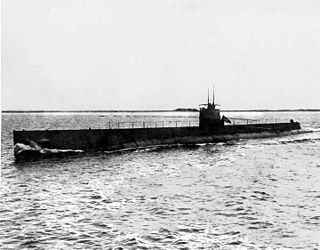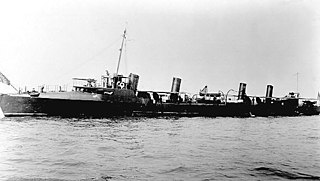
USS Texas was a pre-dreadnought battleship built by the United States in the early 1890s. The first American battleship commissioned, she was built in reaction to the acquisition of modern armored warships by several South American countries, and meant to incorporate the latest developments in naval tactics and design. This includes the mounting of her main armament en echelon to allow maximum end-on fire and a heavily-armored citadel amidships to ensure defensive strength. However, due to the state of U.S. industry at the time, Texas's building time was lengthy, and by the time she was commissioned, she was already out of date. Nevertheless, she and the armored cruiser USS Maine were considered advancements in American naval design.

USS Brooklyn (ACR-3/CA-3) was the third United States Navy armored cruiser, the only one to be named at commissioning for a city rather than a state.

USS New York (ACR-2/CA-2) was the second United States Navy armored cruiser so designated; the first was the ill-fated Maine, which was soon redesignated a second-class battleship. Due to the unusually protracted construction of Maine, New York was actually the first armored cruiser to enter U.S. Navy service. The fourth Navy ship to be named in honor of the state of New York, she was later renamed Saratoga and then Rochester. With six 8-inch guns, she was the most heavily armed cruiser in the US Navy when commissioned.

The first USS Chicago was a protected cruiser of the United States Navy, the largest of the original three authorized by Congress for the "New Navy" and one of the U.S. Navy's first four steel ships.

The Colorado-class battleships were a group of four United States Navy super-dreadnoughts, the last of its pre-Treaty battleships. Designed during World War I, their construction overlapped the end of that conflict and continued in its immediate aftermath. Though all four keels were laid, only three ships entered service: Colorado, Maryland, and West Virginia. Washington was over 75% completed when she was canceled under the terms of the Washington Naval Treaty in 1922. As such, the 16" gun Colorado-class ships were the last and most powerful battleships built by the U.S. Navy until the North Carolina class entered service on the eve of World War II.

The Clemson class was a series of 156 destroyers which served with the United States Navy from after World War I through World War II.

USS Marblehead (CL-12) was an Omaha-class light cruiser, originally classified as a scout cruiser, of the United States Navy. She was the third Navy ship named for the town of Marblehead, Massachusetts.

The AA-1 class was a class of three experimental submarines of the United States Navy, built toward the end of World War I, between 1916 and 1919, intended to produce a high-speed fleet submarine. The design was not a success and none of the submarines saw active service. However, the lessons learned were applied to the design of the later V-boats. The class was later renamed as the T class.

The Pennsylvania class of six armored cruisers served in the United States Navy from 1905 to 1927. All six were renamed for cities 1912–1920, to make the state names available for the new battleships beginning with the Pennsylvania-class battleships. All of these served during World War I, with California being the only ship of the class to be lost. The remaining five armored cruisers were scrapped between 1930 and 1931 in accordance with the London Naval Treaty.

Three Truxtun-class destroyers were built for the United States Navy. Part of the original 16 destroyers authorized by Congress on 4 May 1898 for the fiscal year 1899 program, they were commissioned in 1902. They were very similar to their Bainbridge-class contemporaries, except for mounting six 6-pounder (57 mm) guns instead of five. They were considered the most successful of the first 16 US Navy destroyers, and were succeeded by the larger Smith class.

The New Orleans class of protected cruisers of the United States Navy consisted of two ships which were building for the Brazilian Navy at Elswick, near Newcastle Upon Tyne, England, by Armstrong Whitworth. The Brazilian Navy had ordered four Elswick cruisers, but had already sold the first ship during construction to Chile as Ministro Zenteno. One ship was delivered to Brazil, named Almirante Barroso. The third ship was fitting out as Amazonas, and the fourth was on order as Almirante Abreu.

Tone was a protected cruiser of the Imperial Japanese Navy. The ship was named after the Tone River in Tokyo.

The 3"/50 caliber gun in United States naval gun terminology indicates the gun fired a projectile 3 inches (76 mm) in diameter, and the barrel was 50 calibers long. Different guns of this caliber were used by the U.S. Navy and U.S. Coast Guard from 1900 through to 1990 on a variety of combatant and transport ship classes.

The three Chester-class cruisers were the first United States Navy vessels to be designed and designated as fast "scout cruisers" for fleet reconnaissance. They had high speed but little armor or armament. They were authorized in January 1904, ordered in fiscal year 1905, and completed in 1908. In 1920 all scout cruisers were redesignated as "light cruisers" (CL).

The Derfflinger class was a class of three battlecruisers of the Imperial German Navy. The ships were ordered for the 1912–13 Naval Building Program of the German Imperial Navy as a reply to the Royal Navy's two new Lion-class battlecruisers that had been launched a few years earlier. The preceding Moltke class and the incrementally improved Seydlitz represented the end of the evolution of Germany's first generation of battlecruisers. The Derfflinger class had considerable improvements, including a larger primary armament, all of which was mounted on the centerline. The ships were also larger than the preceding classes. The Derfflinger class used a similar propulsion system, and as a result of the increased displacement were slightly slower.

The St. Louis-class cruisers were a class of three cruisers that served in the United States Navy at the beginning of the 20th century. Authorized in fiscal year 1901 by an Act of Congress of 7 June 1900 as part of the naval buildup touched off by the Spanish–American War, the St. Louis-class cruiser initially began as an improved Olympia. However, during the design phase, decisions were made that increased the size of the vessel from 6,000 long tons (6,100 t) to 9,700 long tons (9,900 t), including adding protection that resulted in the designation "semi-armored cruiser". This led to a larger power plant, and other decisions were made to try to increase speed and range, such as using smaller 6-inch (152 mm) guns instead of 8-inch (203 mm) guns, and adding coal capacity. The completed ship at 9,700 long tons was the same displacement as a full armored cruiser without the same armor. One reference describes the class as "among the earliest well-documented examples of creeping growth in warship design".

The Columbia-class cruisers were two protected cruisers constructed in 1890 and 1891 and used by the United States Navy. They were lightly gunned ships with only moderate armor that were built for the speed needed to overtake and destroy the fast ocean liners of the day as commerce raiders. However, the light armament and armor left these ships over-specialized and outclassed by ordinary similar sized protected cruisers that they might encounter. Also, the engines were expensive to operate and at full power the ships' range was greatly decreased. Due to the ongoing size and speed race in ocean liners, by 1907 they were outclassed in speed by the ill-fated Lusitania and the German liner Kronprinzessin Cecilie.

The Denver-class cruisers were a group of six protected cruisers in service with the United States Navy from 1903 through 1929. Authorized by Congress in 1899 as part of the naval buildup touched off by the Spanish–American War, they were designed with peacetime duties on foreign stations and tropical service in mind, specifically patrolling Latin America and the Caribbean. However, they had insufficient armament, armor, and speed for combat with most other cruisers. Thus, they were also called "peace cruisers" and were effectively gunboats. They were intended to augment the Montgomery class in these roles.

The Cincinnati-class cruisers were two small protected cruisers built for the United States Navy in the early 1890s. They were smaller and more lightly armed and protected than most previous US cruisers, and were intended for commerce raiding. They may also be referred to as Raleigh-class cruisers, as Raleigh was launched and commissioned prior to Cincinnati.



















